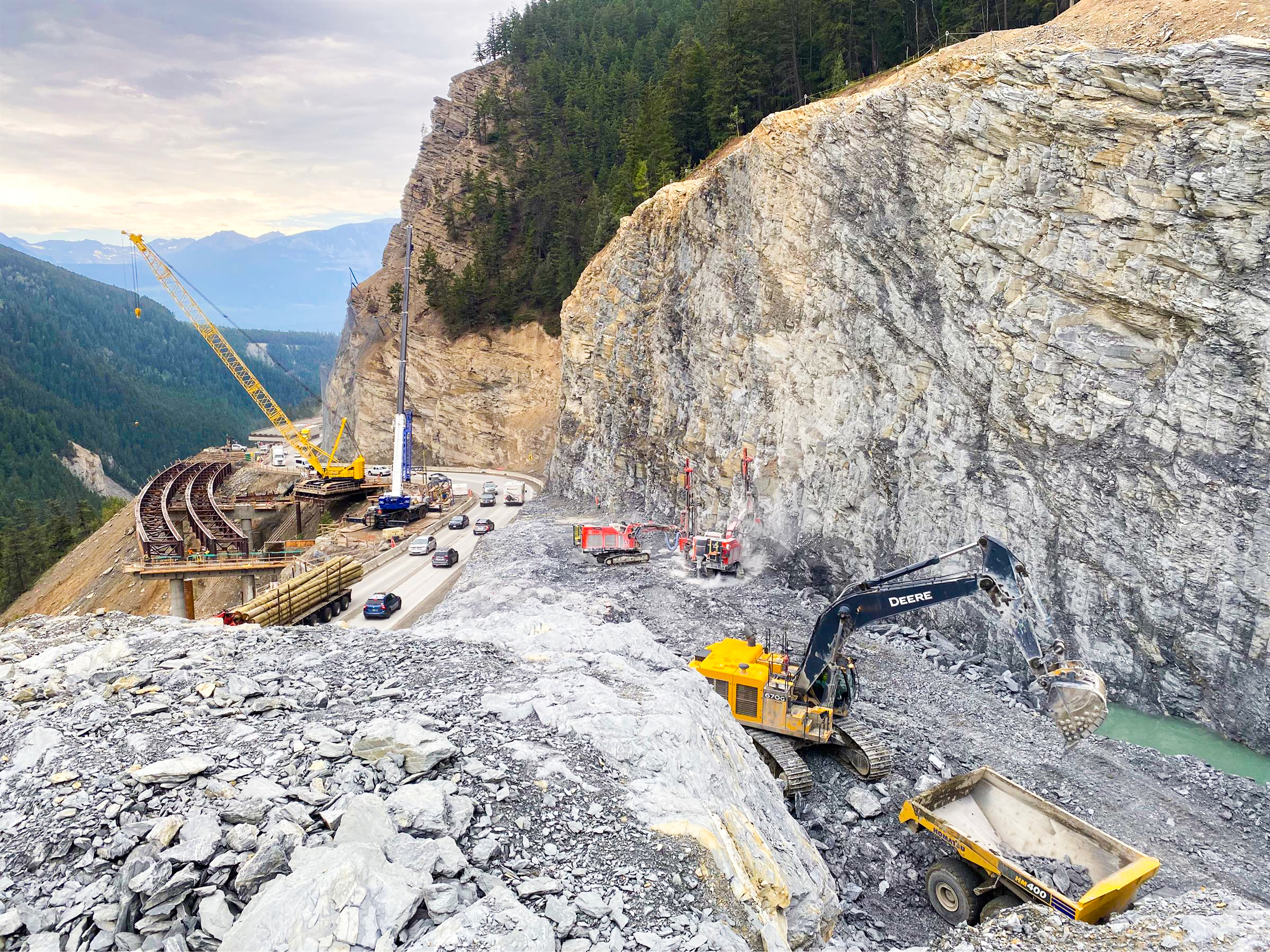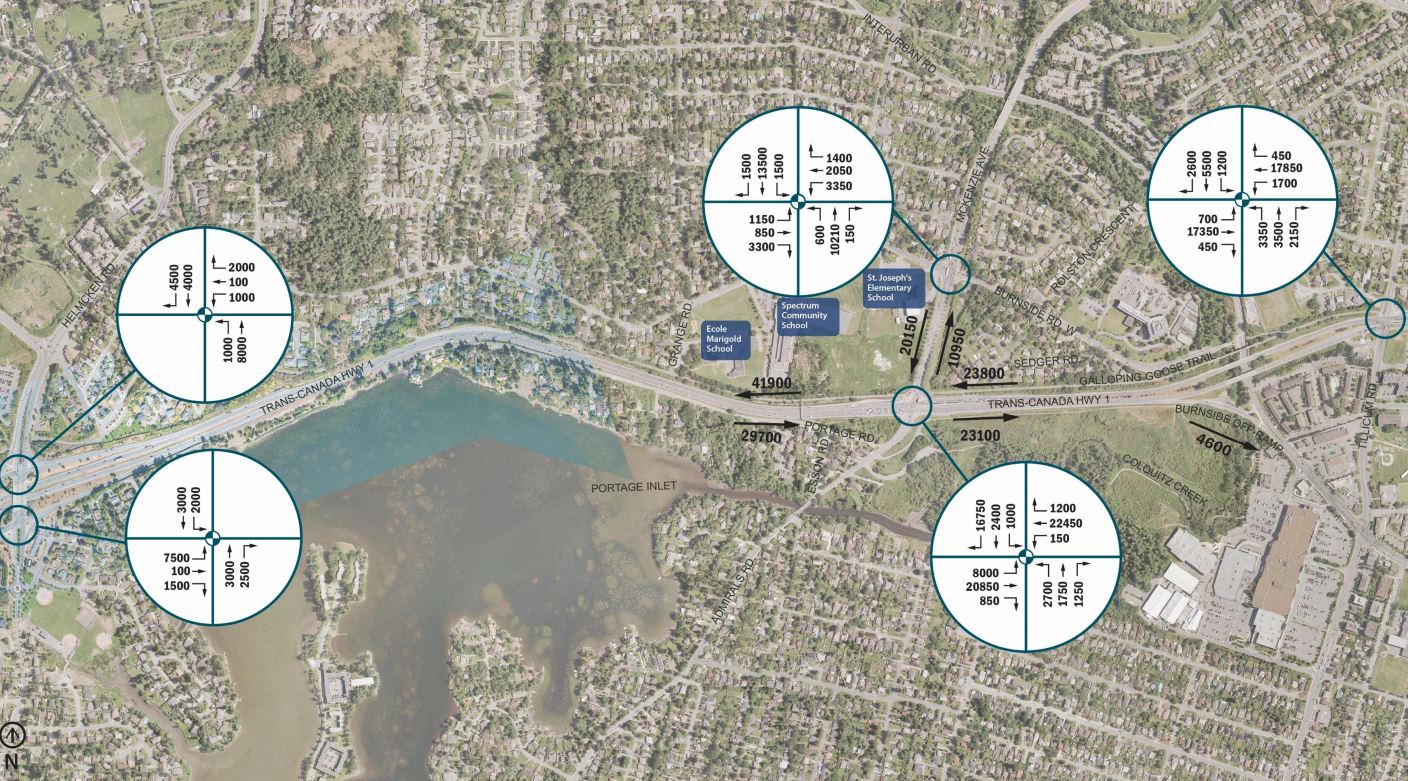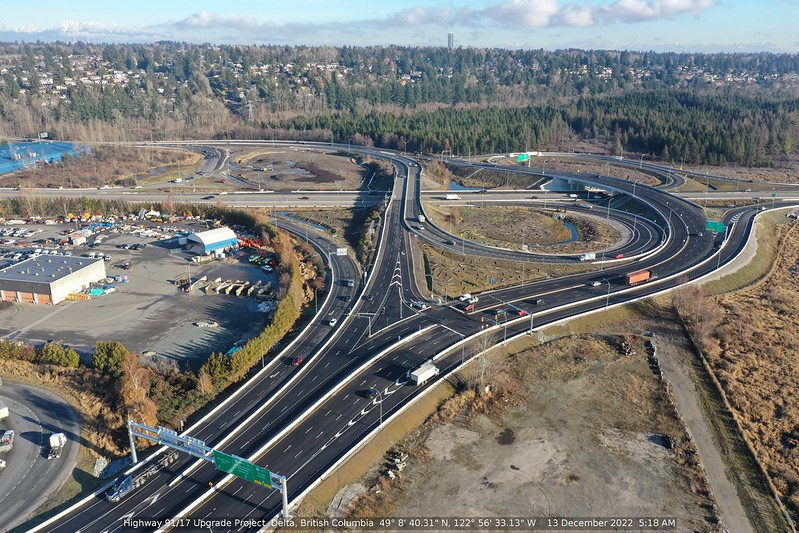 You might become aware of a major transportation project when it’s announced on the news or social media, or by chatting with a friend or neighbour. Or you might learn there is something really big happening from new signs. Then again, your curiosity may be piqued when you see construction markers, big equipment and people dressed in reflective vests at a site.
You might become aware of a major transportation project when it’s announced on the news or social media, or by chatting with a friend or neighbour. Or you might learn there is something really big happening from new signs. Then again, your curiosity may be piqued when you see construction markers, big equipment and people dressed in reflective vests at a site.
With these forms of information, what you don’t see is all the work that goes on for us to deliver huge projects like Highway 91/17 and Deltaport Way, Flood Recovery on the Coquihalla Highway or the Belleville Terminal Redevelopment.
While it’s a lot of work – and a lot of details – we’ve boiled it down for you here. Of course, each project has its unique characteristics and setting, and things might happen differently for each, but this is generally what goes on…
1. PLANNING (the idea)
Studies (the data) – facts to determine the need, like traffic volumes and growth, local development and safety factors.
Stakeholder inputs (the wants) – what we hear from the travelling public, industry, municipalities, First Nations and public consultation like the Sunshine Coast Fixed Link Feasibility Study for example.
Conceptual options (the possible solutions)
- Establishing funding level needed
- Determining what needs and/or wants can be achieved at each funding threshold
- Laying out what happens in the short term, medium term, long term
- Seeking high-level input from engineering disciplines
Outcome of planning phase
- Prioritization of the investment with other priorities and projects on a local, regional and provincial level.
- Securing funding commitments to advance into design phase

2. DESIGN (the selected solutions)
- Assemble project team and bring designers onboard – a typical Ministry of Transportation and Infrastructure project may have 10 staff directly assigned throughout the project and more than 50 involved at some point in time. (This varies greatly on the project’s complexity.)
The skills include:
- Geotechnical engineering to determine:
- How the earth will perform and react to the road and vice versa
- What retaining structures, rock cuts (blasting), earth cuts and fills (excavation) are needed
- How strong the road must be (pavement thicknesses, amount of gravels below the asphalt) based on forecasted use
- Structural engineering – Bridges, tunnels, sign structures, large retaining walls, culverts
- Hydraulic engineering – to address river and creek effects on bridge foundations and how nearby water flow will be managed to avoid undermining the road, and to help ensure the infrastructure (eg. road, bridge, underpass) can withstand extreme flood events
- Traffic engineering – to determine how drivers will navigate the road and the required lane markings, intersections, signal operations and signage.
- Electrical engineering – to plan and program traffic signals, overhead lighting/luminaires, Intelligent transportation solutions (changeable message signs, speed readers boards, variable speed limits, LED signs, webcams, wildlife detection systems)
- Highway engineering –determine the road or bridge’s geometry, curve radius, grades, number of lanes, speed of facility, roadside drainage, and roadside hazard protection.
- Obtain further stakeholder inputs (to ensure the proposed solution meets the “needs” and some or all of the “wants”)
- Determine what is in scope and out of scope
- Investigate user impacts, beyond those of motorists, eg. utilities, municipalities, and other third party infrastructure like railroads or municipal roads
3. CONSTRUCTION (the delivery of the solution)
- Determine the delivery method
- About 99% of our projects take the design, bid, build approach where we contract with an engineering consulting firm to design all or a part of the project. Once the design is finalized, we then go to tender, providing the design drawings and project details, including unique specifications are beyond those in our Manual of Standard Specifications for Highway Construction. The lowest bidder usually becomes the “contractor” and builds the project.
- For some large projects like the Port Mann Bridge and George Massey Tunnel Replacements, the ministry provides information about what we want built and puts out Requests for Proposals for companies who to do both the design and the construction. In some cases, like the Sea-to-Sky Highway, one contractor delivers all aspects of the work – they design, build and operate the bridge or highway.
- Determine work supervision needs
-
- Ministry construction staff to oversee construction
- Consultant staff to oversee works
- Engineer of Record coordination – original designer must review the works to sign off on the final product as meeting their expectations and design intent.
- Property acquisition — assess property needs during or immediately following design, and negotiation to obtain land required to deliver the project prior to construction.
-
- Communicate with stakeholders
- Inform drivers, owners and users of the infrastructure how things will progress during construction, to minimize impacts
- Start construction (aka shovels in the ground)
- For all projects we regularly review updated schedules and financial reports to see how we’re doing on completion dates and budget allocations.
- Some typical construction phases on a grading contract (one part of a major project):
- Survey layout
- Tree clearing and stump removals
- Utility relocations
- Earth excavations and embankment construction
- Blasting
- Engineered gravel placements
- Underground electrical installs (pole bases, conduits, junction boxes)
- Concrete sidewalks and/or curbing
- Paving
- Overhead electrical installation of signal lights, luminaires
- Concrete barrier placement
- Line painting
- Sign installation
(Some tasks may happen at the same time. For example, blasting may take place at one part of the site, and in another area, where that’s already been done, gravel placement and electrical installations might be well underway.)

4. COMPLETION/PROJECT CLOSE-OUT AND HANDOVER (It’s a wrap!)
- Wrap up final construction, address deficiencies, and close out contracts
- Obtain final signoff from design engineers of record of finished product
- Obtain acceptance of the product from district operations staff who will oversee the use and maintenance of the new road/bridge etc.
- Grand opening – ribbon cuttings or other events where the road/bridge is officially opened
- Clerical closeout – project filing, and release of staff back to their departments.
Our major projects involve a whole lot more than this – particularly the construction phase when it comes to putting in bridges, overpasses and underpasses. But those are other stories to be told, with a lot more details of what’s involved in building highway systems that enable you to get around safely and efficiently.
Good morning
I have a better understanding of what is involved in a Major Construction for development now.
Thank you for this detailed information.
Looking forward to updates with photos on the next project.
Very much appreciated
Hi Bruce,
We are so glad you found this informative and interesting. As always, lots of projects on the go and we look forward to sharing updates and photos. Thanks so much for connecting with us here.
We have come a long way since the Cariboo Highway was built through the canyon. BC has some challenging terrain and I think the MOH has done an incredible job. Thanks.
Thanks for this, Joe! Safe travels.
There needs to be follow up on the design of highways that exist from the 1960 today.
The No. 5 highway was built from the early 1960 to approximately 1973.
The major problem is, it was not maintained to that level,
When I look at repaving, we cut up 3 or 4 inches of pavement and repave over top. This is crisis management at best. We never fix the base which is part of the problem of many of factors why pavement break up.
The loads of on the big trucks were never factored in back in 1960’s Also the number of big trucks on the road. This is apparent when we see water pooling or ruts on the road. The traffic that exists today is probably more larger than we could have imagined back then.
I was a former susrveyor on the Location branch back in the day.
Hi Eddie – thanks for connecting with us here. Ministry staff at all levels (from construction to planning and design engineering) review and plan for improvements across all of our provincial highway system, to align with modern standards, as required.
How about fixing the problem in Quesnel B.C. before the highway to the north is completely shut down.
There is more to this province then just Vancouver. Can’t wait for the next election to vote you deaf people out.
Hi Rod – thanks for taking the time to connect with us here. Is there a particular issue you are concerned about? That will help us know where to direct your comment.
I’m surprised that before the Kicking Horse canyon upgrade was started that the Kicking Horse bridge in Golden wasn’t replaced. Apparently, said bridge is due replacement anytime now(?). It’s a major bottleneck when traffic is routed through the town and the ice jam has had to be mitigated already this Winter.
Hi there Reg,
Thanks for your comment. We recognize that the Kicking Horse Bridges pose traffic and maintenance challenges with ice jams in the winter. Kicking Horse Bridges are currently in design phase, so look for future announcements. Safe travels.
Another comment.
Unless there is improved Highway Patrol through all the way from Sicamous to Golden we will NEVER get the accident level acceptable. The amount of dangerous and downright stupid actions ( quite often by so called “professional” drivers) as appalling. We will never be able to build roads the make up for stupid!!
Thanks for your comment Don –
The ministry, in conjunction with ICBC and the BC Trucking Association have recently begun a Mandatory Entry Level Training (MELT) program to build basic skill levels in the trucking industry in BC. Here’s a link to more information on that program. https://news.gov.bc.ca/releases/2021TRAN0140-001884
Unfortunately, while we are responsible for creating the legislation that governs travel on BC Highways, the BC RCMP are responsible for enforcing it. If you have an area which you are particularly concerned about and would like to request additional enforcement, we encourage you to connect directly with the local detachment. We hope this information is helpful. Safe travels.
I go back to 1958/61 when I was a surveyor/grade inspector for DPW on the 7.8 mile section of TCH through Mt. Revelstoke NP. Incidently I do believe that section has stood up over the past 60 years much better than most other sections. Our project engineer and crew were sticklers on drainage and compaction!
Anyway I would have liked to see that BILLION or so DOLLARS now being spent on about 4 or 5 kms east of Golden be ACTUALLY spent on many other areas throughthe Pass where the majority of accidents actually occur. I believe just a bit of regular scaling on that short stretch PLUS ENFORCED 30 KM SPEED LIMIT down as far a Kicking Horse bridge would save many more traffic disruptions and lives than this project going on today!
Just a thought from a very old taxpayer that drives this road regularily!
Hi again Don – thanks for sharing this with us. This work is part of a larger program to modernize the TCH and includes improvements at multiple points along the corridor between Kamloops and Alberta. Here’s a link to more information about the program and if you don’t find the information you are looking for at the link, there is a project email on the page for your suggestions. We hope this information is helpful. Thanks again for connecting with us to share your concerns. https://www2.gov.bc.ca/gov/content/transportation-projects/highway1-kamloops-alberta
I am proud of the work happening in Roger’s pass. Too many governments have ignored that terrible area. Thank you
Thanks for the positive feedback, Dave!
Incredible what you are doing east of Golden. I’m looking forward to driving it when completed.
Hi Robert – thanks for your message. We are excited too! We look forward to getting project update photos and eagerly await the final product.
You are doing amazing work on restoring Hwy 8 from the damage caused by last year’s atmospheric rivers. It would be great if you could do an indepth story on that.
Thanks for your message, Stacey. We will share your message forward. We are tracking work underway to restore Highway 8 at the recovery project website:
https://www2.gov.bc.ca/gov/content/transportation-projects/bc-highway-flood-recovery/2021-flood-road-recovery-projects-highway-8
and the ministry’s Flickr album: https://www.flickr.com/photos/tranbc/albums/72177720296359564
Thanks for the nice step by step description of the behind the scenes
Our pleasure, Todd. Safe travels.
Awesome task…
We think so too 🙂
Or you can take the approach taken to Kamloops to Alberta four laning. No plan, no design, no timescales. The reality is a shortfall on delivering the promise of inadequate funding ($650m over 10 years) and piecemeal work at a rate that will take many decades to achieve the aim of the ‘project’.
Hi Nick,
Thank you again for your comments and continued concern. Under B.C. on the Move, the ministry’s new 10-year transportation plan, the Province is committed to continuing to work with the federal government to fund priority projects on the Trans-Canada Highway, with a goal of increasing the total investment to over $1 billion over the next 10 years. With respect to your comments about the timeline for this work, projects of this magnitude require significant engineering and construction resources and must be carried out over the long term. We hope that this helps.
It would be nice if there was even a faint chance that many of the worst accident blackspots on BC’s most lethal highway (ICBC’s description) would be upgraded in the next decade or two. Unfortunately, given current rates of progress, I would be a fool to expect this to happen.
Be fair Thomas! It was Chrispy Clarke that promised to four lane it to the Alberta boarder for $650 million. Before she galavanted off to Asia to ‘fix’ the housing problem, and before she wasted all the funds on Site C! Do you realize that the Golden Canyon, a massive and impressive project will cost 1 30th of Site C? And that it was never intended to ‘reach the Alberta border’ because the portion through Yoho Park is entirely the responsibility of the Federal government.